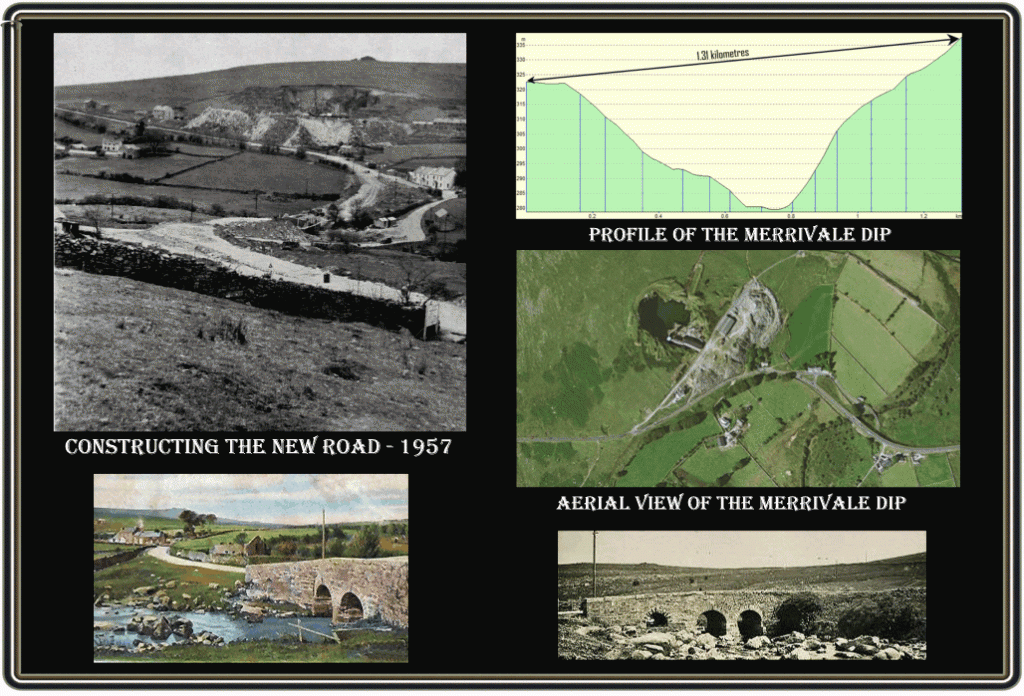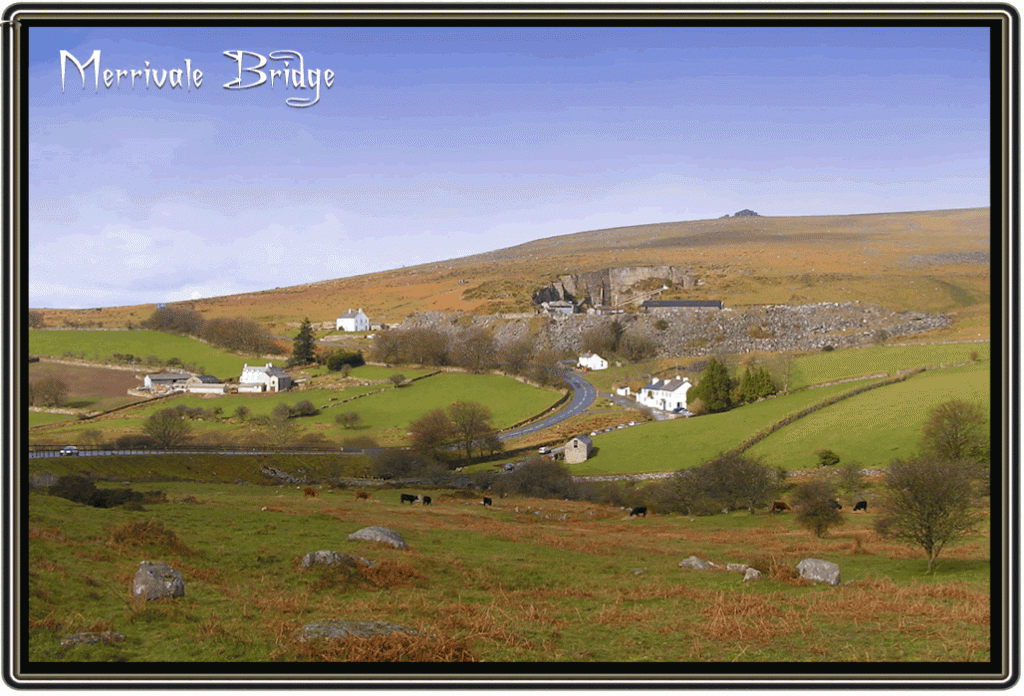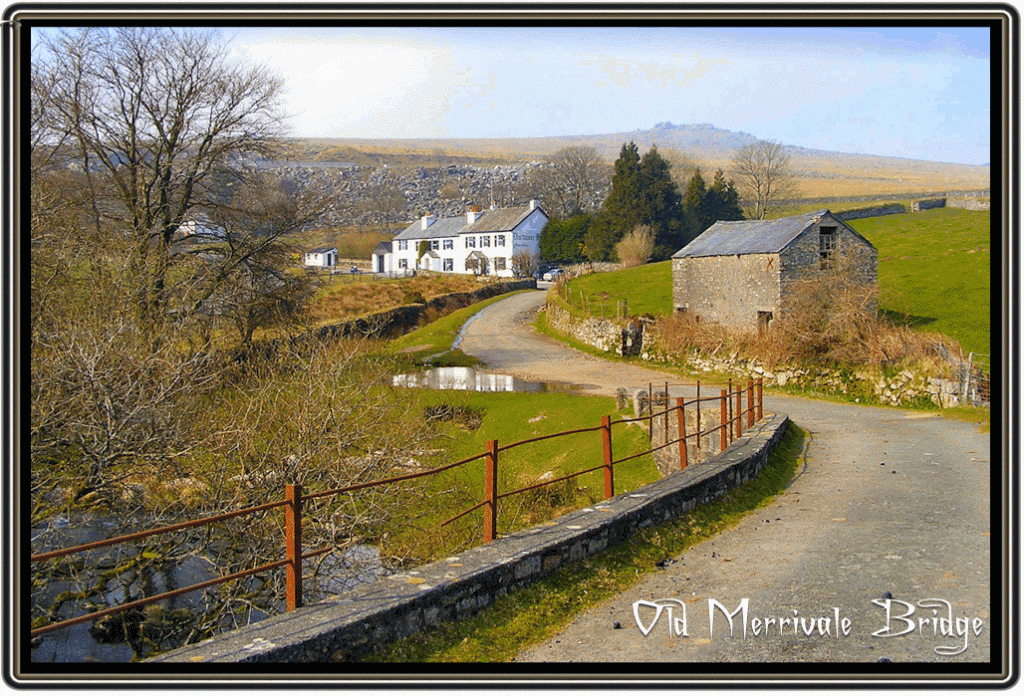
“A new bridge at an awkward bend – work is proceeding on a modern double-width bridge across the River Walkham on the Tavistock to Princetown road. The new bridge is about 50 yards from the picturesque existing bridge, and here the present route takes an extremely awkward double bend. The approaches to the new bridge, also under active construction, will by-pass the bends and so eliminate danger to traffic at a beautiful but ‘black spot’ in part of a tourist country. The old bridge is only 22 ft. wide and large vehicles have not infrequently got stuck in trying to cross.” – The Sphere, May 4th, 1957. (see photograph below).
Regardless whether one travels from Tavistock to Princetown or Princetown to Tavistock on the B3357 you will encounter the ‘Merrivale Dip’ which as can be seen from the profile below is formed by two hills. This 1.3 kilometre stretch of road passes through the tiny hamlet of Merrivale and crosses the River Walkham via Merrivale Bridge. The above newspaper article superbly defines this piece of road in five words – ‘awkward bend‘, ‘black-spot‘ and ‘tourist‘. Today it’s far less perilous as it once was thanks to those 1957 road ‘improvements’ but still it can be a case of fun and games plunging down into the valley bottom or struggling up out of it. Thanks to modern technology the majority of vehicles have efficient braking systems and gear boxes which makes driving much safer. Add to this the ‘supposed’ 40 mph speed restrictions accidents are far less common. Today, provided one drives with care the greatest danger are the sheep which can often be seen in the road. However that has not always been the case as will now be seen.
It is fairly likely that there has been human ‘traffic’ crossing the river Walkham since prehistoric times although this would have consisted of pedestrians. But centuries down the line wheeled vehicles began using what is now the B3357 thus introducing the likelihood of accidents. Combine this with the increase in commerce around the Moor and one began to see large wagons driving along this moorland thoroughfare. In some cases this presented the problem of unpredictable horses, faulty brakes and incompetent wagoners all resulting in accidents, some serious and others humorous. During the late 1800s two other factors led to the increase in traffic flow passing through this section of road, the opening of the quarry in 1876 and the phenomenon of charabanc parties. Merrivale soon became a popular stop-off on these scenic tours of Dartmoor with many coaches passing up and down the road. In 1879 a fruiterer called Mr. Miles from Tavistock was travelling home from Princetown market in a small, uncovered waggonette. Accompanying him was his wife, a Mr. Farnham and his wife and a young man from Plymouth. As they descended the hill the combined weight of the passengers along with the weight of the waggon became too much for the horse to handle. The poor beast sped off down the hill and near Merrivale Bridge it collided with the bank and capsized the waggon. Luckily Mr. Miles and the young man manged to leap out of the waggon as it hurtled down the hill. Unfortunately the others weren’t so lucky and were all tossed into the road. Mrs. Miles received a severe fracture to the base of her skull and Mr. Farnham also sustained serious life-threatening injuries. This being just one example of horse and waggon related accidents on Merrivale Hill. A slightly more amusing incident happened in the July of 1870 involving a driverless Moretonhampstead and Tavistock coach and four horses. For some reason the coachman and guard left the coach and horses unattended. Seeing a chance for freedom the horses trotted off down Merrivale Hill picking up their pace as they went. Clearly they were well accustomed to the road as somehow at speed they managed to navigate what then was the sharp bend, crossed the narrow bridge and pulled up at the inn where they patiently waited for their driver and guard to come puffing down the hill.
As time went on motorised vehicles slowly replaced the traditional horse and waggon and although this form of transport gave greater control to the drivers there were still numerous accidents involving Merrivale Hill and Dip. In the April of 1922 a lorry carrying a party of workmen, women and children was travelling from Taunton to Lostwithial when the driver lost control of the lorry and crashed into a stone wall. After smashing into the wall the lorry overturned pinning some of the passengers under two heavy metal poles that were part of its load. There was also a huge amount of luggage being transported which ended up scattered all over the road. Sadly the worker’s foreman was killed in the accident and nine of the party were badly injured, amongst whom were two of the worker’s wives. In the May of 1934 a lorry carrying a load of machinery was travelling from Melksham to Helston when the driver lost control as it descended the hill coming from Princetown. Once again this vehicle smashed into a wall at the bottom of the hill and as it did so the driver was thrown through the windscreen but luckily was not seriously hurt.
Heavy vehicles were not the only victims of Merrivale Hill as over time numerous motorcars have suffered to ‘curse of the dip.’ In the early 1900s most of these accidents were caused by inadequate braking systems and/or poor driving. For example in 1930 a car travelling from London to Looe was coming down the hill from Princetown when its brakes failed. Despite desperate attempts to control the vehicle the driver piled into a wall thus overturning the vehicle. Luckily all four occupants escaped with minor injuries. In 1938 a similar disaster happened to a man and his wife travelling from Ideford to Tavistock. Once again he lost control of the vehicle as it came down the hill it skidded and crashed it into the wall at the bottom, neither passengers were seriously hurt.
If the hill has caused problems for four wheels imagine what it is like for two wheeled vehicles? In 1939 a motor cyclist from Bradford came hurtling down the hill when it met a car coming up. Unable to steer clear of the on-coming vehicle the motor cyclist collided with it. The rider sustained a just cuts and bruises but his female pillion passenger suffered a fractured hip. Staying on the topic of two wheels we come to bicycles which once more have also fallen victim to the curse of the ‘Merrivale Dip’. In 1902 the Chief Clerk of Dartmoor Prison was cycling from Princetown towards Tavistock when he lost control of the bike and crashed into the ‘infamous’ wall at the bottom. He was obviously ejected off, hit the ground and fell unconscious with serious head wounds, it was also reported at the time that his “machine was severely damaged.”
The above are just a very few examples of vehicles of all descript have come to grief, either on the hill or in the dip which explains why in an effort to improve the road the alterations were undertaken in 1957. However, it was/is not only the road which presented dangers to travellers. Back in 1902 the Tavistock Council were asked to take action to ensure that the huge stones from Duke’s Merrivale quarry no longer rolled from the roadside spoil tips into the road which clearly presented a problem to traffic. As can be seen today action was taken and the spoil heaps made much more secure. But just imagine speeding along the road from Tavistock, approaching the quarry only to find that there were gigantic rocks scattered over the road, it makes a change from the sheep of today. Other perils that occasionally presented themselves at Merrivale come in the form of snow, ice and flood waters. In the August of 1939 torrential rains swelled the River Walkham so much that its depth at the old bridge was 25 ft. This resulted in some 20 or 30 cars stranded in the dip until the flood waters had receded. It was also reported at the time that the flood washed down several sheep and cattle and scoured a good five tons of gravel from the bank. It goes without saying that snow and ice have over time made the Merrivale road impassable on many occasions and 2018 being no exception.
Finally, put vehicles and their drivers in conflict with each other and one gets what is known today as ‘Road Rage’ which can happen anywhere including Merrivale… In the October of 1923 one Mr. Widdecombe Bowden (seriously), a butcher from Tavistock, appeared at Crownhill Police Court charged with being drunk whilst in charge of a motor vehicle, using ‘improper language’ and not having the necessary light on his car. It appears that on the night of the 17th of September one Major Arthur Beresford was driving his car from Princetown to Tavistock. When he came near to Merrivale Bridge his journey came to an abrupt end when he met a car blocking the road. This was at a point where wire laying works had closed half of the road. He approached the vehicle and asked the occupant (Widdecombe Bowden) if he needed any assistance in moving his car to the side of the road thus allowing other traffic to pass. This kind offer of help was met with a torrent of ‘improper language’ from the driver. The major then summoned the help of a nightwatchman who also asked the driver to move his vehicle, again all to no avail and another stream of abuse. Then along came another car driven by a chauffeur who decamped and joined in the discussion. It was at this point Bowden jumped out of his car when it became obvious to all in attendance that he was drunk as a mattress. Bowden then squared up to the chauffeur who immediately threw him onto a bank and pinned him down whilst the other men moved the car out of the way. Then a local clergyman appeared on the scene and tried to calm things down, all without much success. Having cleared the road both drivers went on their merry way and some how the matter was reported to the Tavistock police. By the time two constables arrived at the scene Bowden was found wandering some 400 yards down the road when he was apprehended. At the court hearing both the chauffeur and the nightwatchman were called to give evidence. The nightwatchman was asked by the defence lawyer why he thought Bowden was drunk, he replied quite simply; “because he could not stand up,” – no argument there then! P.C. Hoare from Tavistock then gave his version of events stating that when Bowden was found he had started to walk home and was, “hatless and coatless, absolutely soaked with rain, and stank of liquor.” The P.C. also described Bowden as being like; “a maniac.” and also noted that at a later point Bowden had made a complaint that the constables had broken two of his ribs. The broken ribs were later confirmed by Dr. Hellyer of Tavistock although the cause was not proven.
In his defence Bowden stated that he had only two drinks all day and was not drunk. On leaving the Merrivale he crossed the bridge and made his way up the hill when his car broke down. Despite numerous efforts he could not get it started and then the Major arrived on the scene. However in his version of events it was the major who, in his words; “behaved like a mad dog,” and Bowden denied that he had used any bad language. He then went on to state that once everybody had moved away he continued to attempt to start his car, again to no avail. Therefore the only option he had was to walk home and whilst on that journey he met with the two constables. According to Bowden the two policemen then threatened to; “knock his face off,” then hit him in the ribs and hauled him into their car by his arms and legs.
The defence then gave the evidence of one Harry Stiff (again, seriously) who was working on the roadworks at the time. He said that he had watched the defendant carefully drive his car quite safely over the narrow bridge and around the sharp bends. Therefore to this end it must have proven that Bowden was not drunk and in answer to the charge of having insufficient lights it was stated that the coils of the magneto had got wet hence the lights failing.
Despite an heroic defence attempt Widdecombe Bowden was fined 40 shillings for being drunk and another 40 shilling for using improper language, and ordered to pay the costs of the case, the charge of having the necessary lights on his car was dropped. Additionally the magistrates added that they had carefully considered sending the defendant to jail without the option of a fine but in view of the mysterious broken ribs they chose leniency. Nobody ever established how the ribs were broken?
So there you have the Merrivale Hill and ‘Dip’ which even today can catch out those who are not acquainted with the road and can soon subject them to the ‘Curse of the Dip.’ Certainly in the summertime it can be quite amusing as you follow cautious holiday makers slowly creeping down the hill. Occasionally you will see some drivers distracted by the famous goat which lives in the old livestock pound in the bottom of the dip. Momentarily their attention is drawn away from the road then you see some frantic emergency braking and frantic corrective steering.
 Legendary Dartmoor The many aspects past and present of Dartmoor
Legendary Dartmoor The many aspects past and present of Dartmoor



